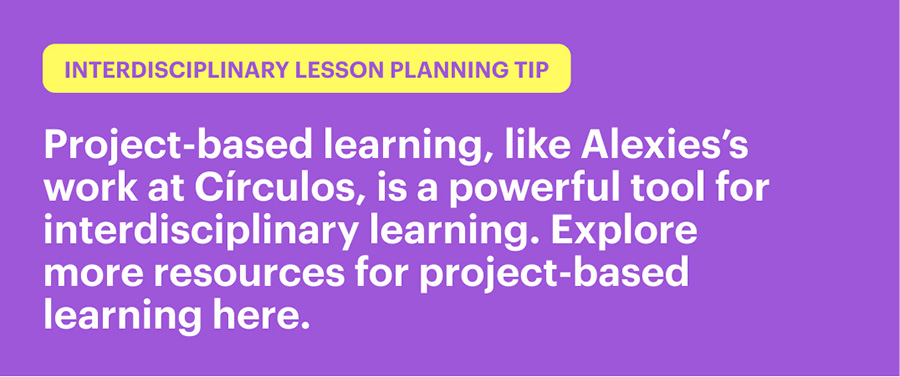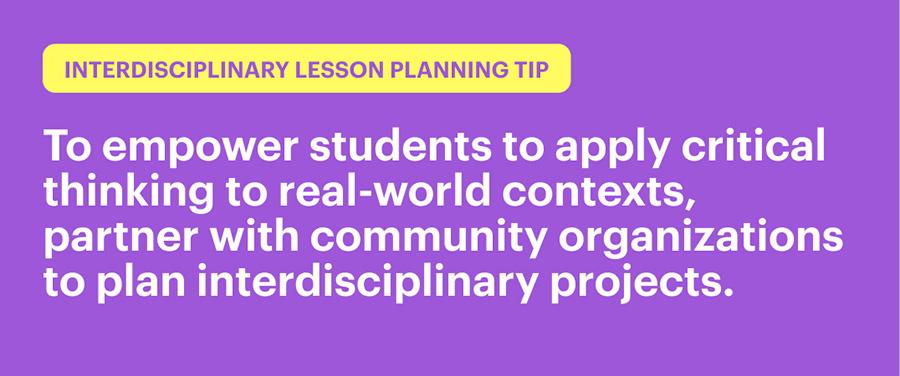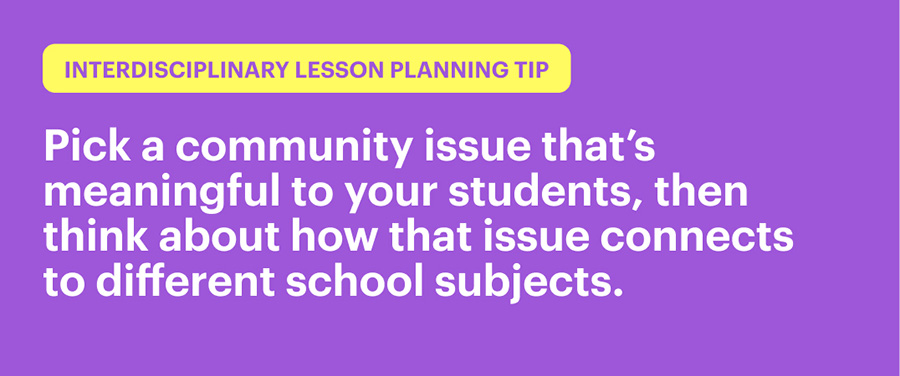When Chris Terrill, the executive director of Crosstown High—an XQ school in Memphis, TN—was diagnosed with high cholesterol, he went straight to his students for help. He didn’t just want an explanation for why his cholesterol might be high—he wanted a plan to lower his cholesterol moving forward. His students delivered, applying insights from biology, health, and product research to come up with a comprehensive health plan.
This project is an example of real-world interdisciplinary learning in action. The Crosstown students synthesized perspectives from multiple subjects to solve a problem. In doing so, they not only learned relevant academic content, but also honed skills like critical thinking and communication.
At XQ, we believe high schools should prepare students to succeed in a world that’s always changing. We’re on a mission to transform high school so that every student has access to meaningful, engaged learning—learning that is deeper, more flexible, and more interconnected than traditional high school curriculum. Interdisciplinary teaching and learning is a way to do just that.
What Is Interdisciplinary Teaching and Learning?
Interdisciplinary teaching and learning is exactly what it sounds like: students combine learning from multiple disciplines to come up with new ways to think about issues and solve problems.
Teachers looking to create these opportunities for students might ask, what is an interdisciplinary approach? Compared to traditional approaches, an interdisciplinary approach expands what students learn by allowing them to tackle problems that don’t fit neatly into one subject. It also changes how students learn by asking them to synthesize multiple perspectives, instead of taking what they’re told by a teacher at face value.
For an example of interdisciplinary learning, take this project from the theater program at Trinity Academy for the Performing Arts (TAPA) in Providence, RI. ShaLayla Simmons, theater teacher and artist-in-residence, led students in writing, staging, and directing plays based on their own life experiences, interests, and natural curiosities. The students also studied well known plays from across history—a Greek drama, a play by Tennesse Williams, and a play by Lorraine Hansberry. This project was interdisciplinary in that it connected literature with historical perspectives, creative work, and material from students’ own lives. In doing this project, students made deep connections between their own identities and the plays they read, gaining new insights into both.
[
Just for Teachers: Give Me Five
Five great reads in your inbox, every two weeks.
SIGN UP
]
As this example from TAPA shows, much of the power of interdisciplinary learning lies in how it teaches students to think and make connections. In partnership with the National Science Foundation, The Science and Research Institute at Carleton College (SERC) identified four major cognitive skills that interdisciplinary learning teaches students, including the ability to:
- Recognize biases
- Thinking critically
- Embracing ambiguity
- Analyzing ethical concerns
These cognitive skills are crucial for high schools looking to transform learning and prepare students for success after graduation. Daniel Allen, former executive director of school renewal with the Santa Ana Unified School District, explained, “The economy right now favors the weird; favors the new; favors the out-of-the-box thinkers.” Interdisciplinary learning helps students learn creatively and apply knowledge across disciplines.

Challenging Student Biases With Interdisciplinary Learning and Teaching
Like all of us, students bring pre-existing ideas, biases, and prejudices into the classroom. These can affect what students learn, how they learn, and how they apply what they learn in school to their lives.
Interdisciplinary learning challenges these biases. It asks students to consider multiple perspectives and, in doing so, trains students to think more critically about their own identities. This approach engages students because it forces them to set aside preconceived notions, enabling them to:
- Learn more readily
- Get a deeper understanding of the material
- Be open-minded to new ideas, concepts, and ways of doing things
At Círculos, an XQ school in Santa Ana, CA, students like Alexies experienced the perspective-widening benefits of interdisciplinary learning. Círculos uses interdisciplinary learning as part of its mission to empower students to become more active in their community. Along with a classmate, Alexies completed a research project at the intersection of culture and public health, focusing on the mental health challenges experienced by students from immigrant families.
Through this research Alexies not only learned about the social, political, and psychological factors affecting families impacted by deportation—she also gained a new perspective on her own life. She explained, “It really made me appreciate the opportunities I have,” Alexies said.

Why Is Interdisciplinary Learning Important?
When students graduate, they should be able to evaluate complex information to come up with their own ideas and perspectives—a.k.a., critical thinking. Interdisciplinary learning supports critical thinking by helping students:
- Understand multiple viewpoints
- Evaluate conflicting perspectives
- Build structural knowledge
This last bullet point, “structural knowledge,” is a term used by interdisciplinary education expert Dr. Allen Repko. As shown in the table below, it refers to the level of knowledge students need to get to a point of forming their own ideas and solutions to a given problem.
| How Interdisciplinary Learning Leads to Structural Knowledge | |
| Declarative knowledge | Students learn how and why things work the way they do |
| Procedural knowledge | Students identify and understand the steps necessary to arrive at a solution |
| Structural knowledge | Students can combine both declarative and procedural knowledge to solve complex problems |

Problem-Solving With Interdisciplinary Approaches
Many of the biggest challenges high school students will face in their education, careers, and communities don’t have clear answers. That’s why one of XQ’s Learner Goals is “original thinkers for an uncertain world.” Comfort with uncertainty and ambiguity is built into the fabric of interdisciplinary learning, where students constantly analyze multiple, sometimes conflicting, perspectives.
By asking students to consider problems through multiple perspectives, interdisciplinary approaches bring an ethical lens to learning. Asking students to express their thoughts and beliefs is a great way to engage student learning in the moment. A focus on ethics also prepares students to pursue justice in their lives outside of school.
When shelter-in-place orders first took effect, Da Vinci RISE High engaged students in questions of ethics through a three-month interdisciplinary project. Students created an identity wheel to explore how voting affects people with different heritages, genders, and sexual orientations. They then presented their final products and narrative at an online student exhibition. This interdisciplinary project engaged students during the challenging time of the pandemic. It also explored the ethics of systematic disenfranchisement and empowered students to speak out on the issue.

How Interdisciplinary Teaching Promotes Meaningful, Engaged Learning
All of these processes—interrogating bias, thinking critically, embracing ambiguity, and analyzing ethical concerns—require deep student engagement. In traditional high school classrooms, the teacher is at the center delivering knowledge. We know that this model does not do enough to engage and empower students. Interdisciplinary learning changes the dynamic, placing students in a much more active role by:
- Allowing students to incorporate their unique subject-area strengths in multiple projects
- Placing learning in a broad context that’s relevant to students’ lives
- Encouraging students to make connections across wide areas of learning
Teachers at Círculos capitalized on these benefits of interdisciplinary learning when they planned a project to welcome incoming 9th graders to the school. In the six-week series, “Ash and Feather: Stories Inside Out,” 9th grade students explored how to tell the story of who they are by looking at examples from a range of disciplines, including creative writing, photography, and painting. Then, students worked to find the best way to represent their own story.
Student Abdiel described how his project, which focused on social and economic justice, evolved from a piece of visual art to a poem with the encouragement of his teachers: “They helped me find my voice. They showed me how to express myself using the simplest of words, and find a kind of beauty.” Abdiel was not the only student who engaged with this project at a deep level. “At the debrief circle, students started crying,” explained Deborah Park, Círculos’ curator of projects and partnerships. “They said it changed their whole perspective. It helped them realize we’re more similar than different.”
How to Teach Using an Interdisciplinary Learning Model
After considering all the benefits of interdisciplinary learning, you might be wondering—how can I actually implement it in my classroom? The Science and Research Institute at Carleton College put together this step-by-step approach:
- Pre-instructional planning
Plan and establish the topics students will examine. Develop an action plan—a set of notes and open-ended questions—that can help guide the classroom experience, whether in person or virtual. - Introduce the methodology to students
Explain what interdisciplinary learning is, why it’s important, and how it’s different from discipline-based learning. You can show students examples of how other students have used interdisciplinary learning to create amazing work! - Take it to the classroom
Show students how to use insights from different disciplines by exploring questions with an interdisciplinary lens together. For a deep dive into how to apply an interdisciplinary lens, check out Allen Repko’s nine-step approach. - Practice interdisciplinary thinking
Ask students to consider an issue using one discipline. Then, ask them to use knowledge from a different discipline to inform their analysis and find a solution. You can ask students to perform this task alone, but it’s helpful to break up students into groups to promote collaboration and invite differing perspectives. Student groups can bring their work back to the entire class and refine their analysis. - Provide feedback
Evaluate students using a detailed rubric. Aim to provide students with feedback on their ability to understand the structure and analytical framework of relevant disciplines, as well as how they use knowledge from those disciplines to create an integrated analysis. - Assessment
Teach students to self-evaluate regularly throughout each project, assignment, or analysis. Ask students to rate themselves on their ability to:- Identify and apply multiple disciplines relevant to the issue or problem they’re studying.
- Synthesize insights from multiple disciplines.
- Integrate ideas across disciplines.
To see these steps in action, explore SERC’s example of how to apply these steps to teach about the racial wage gap.

Advice From Teachers on How to Create Interdisciplinary Projects
How do teachers who’ve made the shift to interdisciplinary learning feel about it? And what would they say to other teachers starting out on their interdisciplinary learning journey? At Purdue Polytechnic High School, an XQ school in Indianapolis, Indiana, teachers (or “coaches”) say interdisciplinary learning has made a big difference for their students.
Humanities Coach Alicia Johnson described how the shift was a“productive struggle”—but said that despite the difficulty, she wouldn’t want to go back to traditional school. “I don’t know that I felt that way in the beginning,” she said. “I think it might have been a relief to have some familiarity, but now I couldn’t live with myself going back to that.”
Two big themes educators at PPHS emphasized for creating interdisciplinary learning are collaboration with other teachers and constant self-evaluation and innovation. Lead Instructor Andrew Goodin explained, “The fact that [teachers and students here] are scheduling on a weekly basis allows us to iterate really, really rapidly. Then the nature of the space causes serendipitous interactions all the time. You know, because we are sharing a classroom space, we’re able to just hop on over, ask a quick question and then use that real-time to adjust course.”
Educators at PPHS also offer these tips to guide your interdisciplinary lesson planning:
- What are the state academic content standards and related concepts that we need to teach?
- What content knowledge and experiences are going to be necessary for students to succeed in the Purdue University Pathway of their choice? (You can replace “Purdue University Pathway” with a learner goal that makes sense for your school!)
- To what industries do students need better exposure and access?
- Who are the potential industry partners and experts in our state?
- What challenge questions would deeply engage students in real-world problems?
For more tips from educators, check out these lists compiled by Latitude High School and Da Vinci Rise High, with ideas like:
- Ask students to share their findings outside of the classroom—with the community, friends, and family.
- Start small by consulting with other teachers and collaborating on how to scaffold interdisciplinary instruction.
- Be sure to incorporate reflection time for yourself and your students to unpack how and what they learned.
Student Benefits From Interdisciplinary Teaching and Learning
Interdisciplinary learning benefits students at all levels of learning. Here are several areas where interdisciplinary learning is particularly powerful, in the words of teachers and students:
- Providing high rigor:
High school students need to be challenged to reach their full potential, and interdisciplinary learning provides students with an appropriate level of rigor. Explore how TAPA used interdisciplinary learning to help raise the standard for math and science at their arts-based school. As TAPA director of teaching and learning Ammar Zia explained, “By holding our students to high rigor, the TAPA team sends them a message of love that they deserve and will master high expectations. The interdisciplinary curriculum itself says that our students—many of whom are poor, students of color—can do the rigorous work. That—in and of itself—is social justice.” - Highlighting student voice:
Interdisciplinary learning is inherently student-driven, with students making connections across disciplines and synthesizing perspectives to come up with their own original ideas. This approach empowers students to see their own voice and ideas reflected in their academic accomplishments. Círculos student Alexies explained: “During my sophomore year, I created a literacy program for kids during the summer called Children Read Together. This was funded by the Dragon Kim Foundation. My partner and I had our program at local libraries and the OC Rescue Mission. Working with the foundation gave me power and made me feel that I was born with a purpose and that my voice matters. For the first time I was not just a student, but an educator. I had the power to impact other students’ lives.” - Building community connections:
Interdisciplinary learning supports focus on real-world problems, and invites expertise from many different sources—the perfect setup for students to build connections with community members and organizations. Students at New Harmony High School, an XQ school in New Orleans, LA, built a powerful community connection when they partnered with 826 New Orleans to write, discuss, edit, and publish a book of short stories that imagines New Orleans in a future of unchecked climate change. In this project, which merged humanities, science, and storytelling, students got to learn from the perspective of professional writers. New Harmony teacher Jeff Carver explained, “There’s always a great benefit when you can connect students with professionals in whatever field they’re studying. Students learn how these folks got to where they are, what it’s like to do this particular job as a career, how it relates to what students are working on in school.” - Cultivating future-readiness:
The problems students will be asked to solve in future jobs, communities, and college courses are interdisciplinary. An interdisciplinary approach to high school prepares students for this future, equipping them with relevant experiences before they even graduate. Autumn, a graduate of Iowa BIG—an XQ school Cedar Rapids, IA—described how she gained real-world experience through interdisciplinary projects in high school: “My job working in a pharmacy inspired me to start a project addressing teen opioid addiction. I wanted to know if there was a way addicted teens could ask for help at school. Our team researched school handbooks around the country and we couldn’t find a single example. Working with a local addiction rehabilitation center, we drafted a new policy to present to our local school board. Now that I’ve graduated, another student is leading this project and a new team through its completion.”
Final Thoughts on Interdisciplinary Learning
When Josue Alcaide graduated from Círculos, he had this to say: “My most valuable lesson learned at school is that no matter how hard things might be, or how irrational life may get, trust in the process and keep your head held high. You have to persevere to thrive.”
Without using the words “interdisciplinary learning,” Josue touched on learning themes that are hallmarks of Círculos’s interdisciplinary focus, like trusting in the process of learning and persisting in the face of ambiguity.
Interdisciplinary learning empowers students as thinkers, collaborators, and problem-solvers, in high school and in the world at large. We hope you use interdisciplinary learning to engage students, educators, and community partners around meaningful learning experiences.
Are you curious about how to rethink the high school experience? Are you hungry for more resources to help you do just that?
XQ has you covered! Subscribe to Give Me Five and get best-in-class resources curated by XQ to help you reimagine high school education in your community.